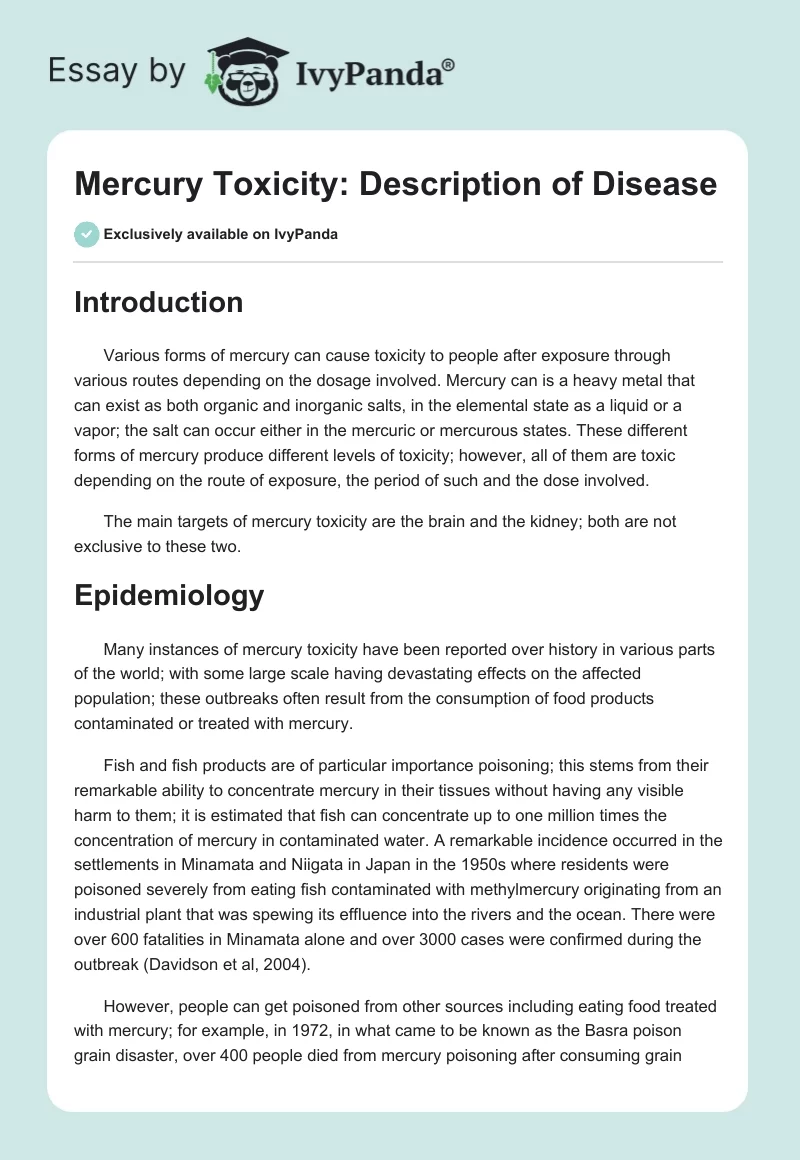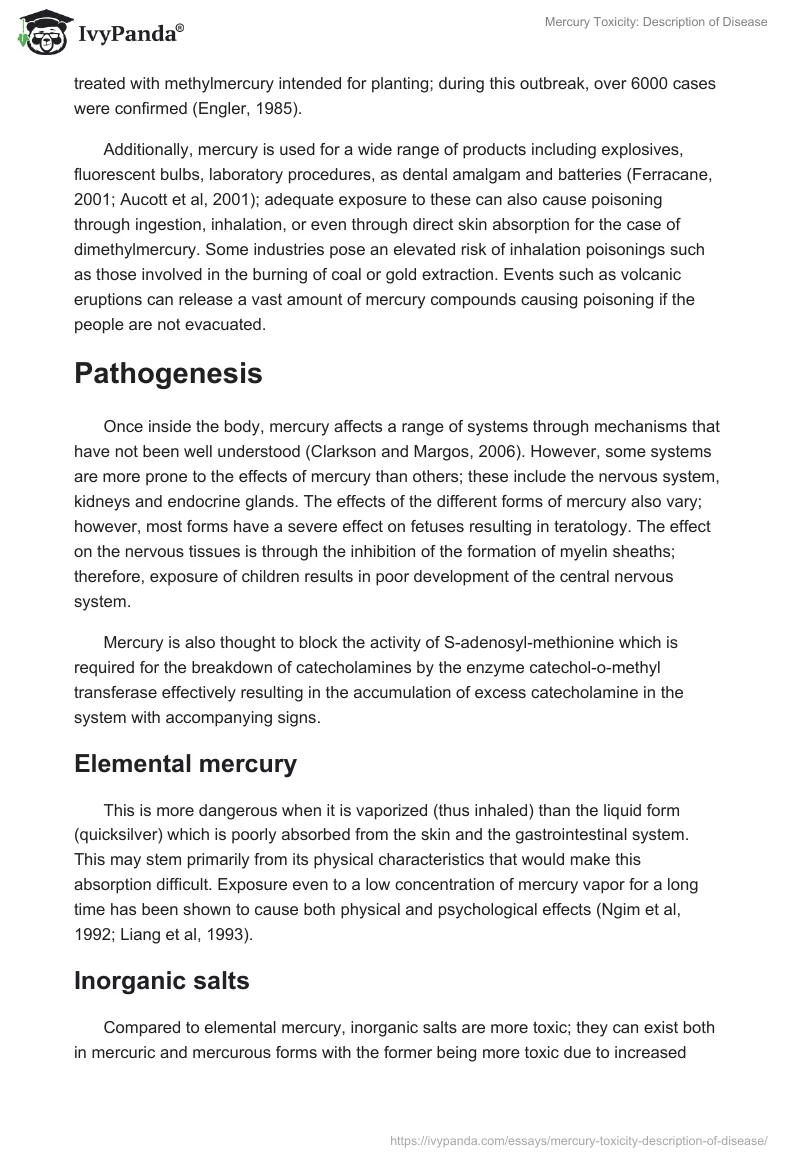Introduction
Various forms of mercury can cause toxicity to people after exposure through various routes depending on the dosage involved. Mercury can is a heavy metal that can exist as both organic and inorganic salts, in the elemental state as a liquid or a vapor; the salt can occur either in the mercuric or mercurous states. These different forms of mercury produce different levels of toxicity; however, all of them are toxic depending on the route of exposure, the period of such and the dose involved.
The main targets of mercury toxicity are the brain and the kidney; both are not exclusive to these two.
Epidemiology
Many instances of mercury toxicity have been reported over history in various parts of the world; with some large scale having devastating effects on the affected population; these outbreaks often result from the consumption of food products contaminated or treated with mercury.
Fish and fish products are of particular importance poisoning; this stems from their remarkable ability to concentrate mercury in their tissues without having any visible harm to them; it is estimated that fish can concentrate up to one million times the concentration of mercury in contaminated water. A remarkable incidence occurred in the settlements in Minamata and Niigata in Japan in the 1950s where residents were poisoned severely from eating fish contaminated with methylmercury originating from an industrial plant that was spewing its effluence into the rivers and the ocean. There were over 600 fatalities in Minamata alone and over 3000 cases were confirmed during the outbreak (Davidson et al, 2004).
However, people can get poisoned from other sources including eating food treated with mercury; for example, in 1972, in what came to be known as the Basra poison grain disaster, over 400 people died from mercury poisoning after consuming grain treated with methylmercury intended for planting; during this outbreak, over 6000 cases were confirmed (Engler, 1985).
Additionally, mercury is used for a wide range of products including explosives, fluorescent bulbs, laboratory procedures, as dental amalgam and batteries (Ferracane, 2001; Aucott et al, 2001); adequate exposure to these can also cause poisoning through ingestion, inhalation, or even through direct skin absorption for the case of dimethylmercury. Some industries pose an elevated risk of inhalation poisonings such as those involved in the burning of coal or gold extraction. Events such as volcanic eruptions can release a vast amount of mercury compounds causing poisoning if the people are not evacuated.
Pathogenesis
Once inside the body, mercury affects a range of systems through mechanisms that have not been well understood (Clarkson and Margos, 2006). However, some systems are more prone to the effects of mercury than others; these include the nervous system, kidneys and endocrine glands. The effects of the different forms of mercury also vary; however, most forms have a severe effect on fetuses resulting in teratology. The effect on the nervous tissues is through the inhibition of the formation of myelin sheaths; therefore, exposure of children results in poor development of the central nervous system.
Mercury is also thought to block the activity of S-adenosyl-methionine which is required for the breakdown of catecholamines by the enzyme catechol-o-methyl transferase effectively resulting in the accumulation of excess catecholamine in the system with accompanying signs.
Elemental mercury
This is more dangerous when it is vaporized (thus inhaled) than the liquid form (quicksilver) which is poorly absorbed from the skin and the gastrointestinal system. This may stem primarily from its physical characteristics that would make this absorption difficult. Exposure even to a low concentration of mercury vapor for a long time has been shown to cause both physical and psychological effects (Ngim et al, 1992; Liang et al, 1993).
Inorganic salts
Compared to elemental mercury, inorganic salts are more toxic; they can exist both in mercuric and mercurous forms with the former being more toxic due to increased solubility. These compounds affect primarily the gastrointestinal system and the kidney with severe effects on the latter. However, the salts do not cause a very severe effect on the CNS due to their inability to cross the blood-brain barrier unless in a very high concentration of chronic exposure (Langford & Ferner, 1999).
Organic mercury compounds
This form is among the most toxic compounds of mercury causing severe CNS and hepatic damage; some can cause fatality from exposure to minute drops on the skin for example dimethylmercury.
Methylmercury has been the culprit of many cases of poisoning drawing from its ability to accumulate up the food chain especially in fish (Hunter et al, 1940). The compound shows a unique latent period before the appearance of potentially fatal symptoms; this is thought to be determined by a threshold concentration rather than the period of exposure.
Clinical presentation
The effects of the accumulation of acetchlamines in the body include hyperhidrosis, tachycardia and mercurial ptylism. The person may also have hypertension. Effects on the nervous system include paresthesia, pruritus, or having a burning sensation on the skin. The skin may be affected showing erythema, edema, and sloughing of the epithelium
Children are particularly vulnerable to the severe effects of mercury poisoning. Signs include epilation, erythema on the skin and lips, photophobia, and loss of muscle tone. The kidneys are also affected and the child may show CNS signs.
Diagnosis
The ability to diagnose poisoning from elemental mercury or its inorganic salts is varied; these two forms have a short half-life in the blood thus detection of low levels may be misleading. Urine levels can be used as a criterion for diagnosis; however, this becomes extremely unreliable if the person is undergoing chelation treatment which tends to increase the concentration of mercury in urine (Ibrahim et al, 2006).
For organic mercury poisoning, the most reliable, whole blood is more accurate in the detection of poisoning; demonstration of levels of mercury in hair is also important (Ibrahim et al, 2006).
Management
Removal of the source of poisoning is crucial to prevent further entry of mercury into the body through any route; this involves discontinuation of the offending diet (fish, grain). The standard treatment for mercury poisoning is chelation therapy.
Some of the chelating agents that may be used for the treatment of acute poisoning with salts of mercury include 2, 3-dimercapto-1-propanesulfonic acid (DMPS), D-penicillamine (DPCN) and dimercaprol (BAL) [Clifton, 2007; Risher and Amler, 2005]. The correct dosage and procedure of therapy are very important for optimum results; additionally, the treatment should be instituted as soon as a positive diagnosis is done so as to reap the maximum benefits of treatment.
Follow up care
Compared to chronic toxicity, acute mercury poisoning has a fairly good outcome of treatment and care; it is however very important to avoid any further exposure during the post-treatment period to allow the body to get rid of the mercury that was not removed by the chelation through natural mechanism (Risher and Amler, 2005).
Chronic mercury poisoning can result in severe damage especially in children and during the prenatal period leading to lifelong debilitating effects requiring specialized care.
Summary
- People can get poisoned by mercury in either its elemental form especially mercury vapor, inorganic and organic salts,
- Organic salts are among the most toxic forms of mercury
- There are many sources of mercury poisoning including contaminated food, industrial activities and natural phenomena.
- Mercury compounds are able to increase up the food chain due to the processes of bioaccumulation and biomagnification resulting in inadvertent consumption of massive doses of mercury in everyday foods
- Consumption of fish and fish products, in particular, can pose a great risk due to their unique ability to concentrate the massive amount of mercury in their tissues without suffering any visible effects.
- Poisoning can occur via ingestion, inhalation or direct skin absorption
- The poison targets nervous tissues, the kidney and the endocrine system with accompanying signs
- Prenatal exposure to mercury can result in serious teratological effects
- Poisoning is treatable through the administration of chelating agents; however, some effects from chronic exposure especially in children can be irreversible.
References
- Aucott M, McLinden M, Winka M, (2003). Release of Mercury from Broken Fluorescent Bulbs: Journal of Air Waste Management Association 53:143-151.
- Clarkson TW, Magos L (2006). The toxicology of mercury and its chemical compounds. Critical Review of Toxicology 36 (8): 609–62
- Clifton JC 2nd (2007). Mercury exposure and public health. Pediatr Clin North America 54 (2): 237–69, viii
- Davidson PW, Myers GJ, Weiss B (2004). Mercury exposure and child development outcomes. Pediatrics 113 (4 Suppl): 1023–9
- Engler R (1985). Technology out of Control: The Nation 240.
- Ferracane, Jack L. (2001). Materials in Dentistry: Principles and Applications. Lippincott Williams & Wilkins. pp. 3.
- Hunter D, Bomford RR, Russell DS (1940): Poisoning by methylmercury compounds. Quarterly Journal of Medicine 9: 193–213.
- Ibrahim D, Froberg B, Wolf A, Rusyniak DE (2006). Heavy metal poisoning: clinical presentations and pathophysiology. Clin Lab Med 26 (1): 67–97, viii
- Langford NJ, Ferner RE (1999). Toxicity of mercury. Journal of Human Hypertension 13 (10): 651–656.
- Liang YX, Sun RK, Chen ZQ, and Li LH (1993): Psychological effects of low exposure to mercury vapor: Application of computer-administered neurobehavioral evaluation system. Environmental Research 60: 320–327.
- Ngim CH, Foo SC, Boey KW, and Keyaratnam J (1992): Chronic neurobehavioral effects of elemental mercury in dentists. British Journal of Industrial Medicine 49: 782–790.
- Risher JF, Amler SN (2005). Mercury exposure: evaluation and intervention the inappropriate use of chelating agents in the diagnosis and treatment of putative mercury poisoning. Neurotoxicology 26 (4): 691–9.


